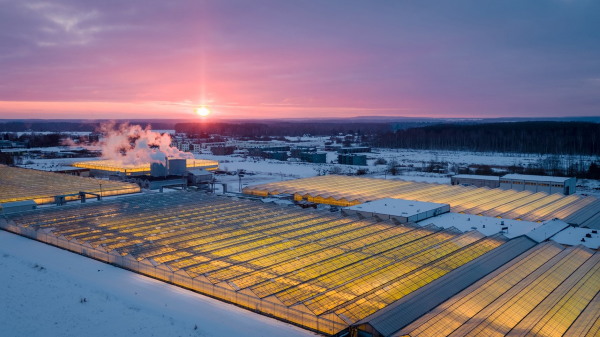About one year ago, we wrote an article with the title; Growing Lettuce Locally: how close can you get? The article focused on how Finnish greenhouse growers have achieved price and cost parity with field grown produce. The climate in Finland makes it challenging to grow in the fields due to a very short growing season. Growing in a greenhouse is the only option to produce fresh produce more than 4 months per year. Indoor growing of leafy greens has been done on a large scale for decades. In order to be competitive with the imported field grown lettuce the Finnish greenhouse growers have had to operate very effectively, always striving to optimize and make their operation cost efficient. Today about 90% of all leafy greens grown in the country are cultivated locally in a greenhouse, says Tero Laakso, the CEO of Green Automation Group.
This has resulted in greenhouse grown produce taking over the retail market, essentially completely replacing the field grown lettuce in the grocery stores and even largely replacing imported field lettuce, except in categories such as heads of Iceberg. The business model that has proven to be successful for the Finnish greenhouse operators is based on three significant factors: High-tech, location and size.
- High-tech: Efficient and automated NFT (NFT – Nutrient Film Technique) growing system (maximizing the yield/m2 and reducing the need of manual labor)
- Location: Strategic location (close to but outside of metropolitan areas, close to distribution centers, ideally with the possibility to use a direct heat source such as a power plant)
- Size: Large operations (economies of scale)
The Finnish Lettuce Model is catching on
An example of applying the ‘Finnish Lettuce Model’ is Grüne Fee in Estonia. Grüne Fee operates a greenhouse facility in Tartu, growing leafy greens and other crops. The greenhouse is strategically located directly next to a power plant and about 200 km from the capital Tallinn. This fall Green Automation will install additional growing lines at Grüne Fee. This will be the 3rd expansion of their leafy greens operation.

Grüne Fee, Tartu Estonia Photographer: Janno Vään
“While we are not surprised to see this model continue to be executed in the Nordic and Baltic home markets, we are pleased to see this concept be applied more and more across North America and the world,” says Tero Laakso, CEO, Green Automation Group.
“We anticipate the leafy greens production to follow a similar development curve as the greenhouse tomato production in North America, which has increased tremendously over the last 20 year. CEA produced lettuce and herbs might still be niche products today, but we are forecasting that the market share for this segment will grow by 50% annually over the next years,” says Laakso.
The challenges in the field lettuce industry such as lack of water, land and labor as well as food safety concerns, pesticide use, extreme weather events, high transportation emissions and food waste have been pushing for this development for a long time now. The current COVID-19 pandemic has made it even more evident that we need locally grown food and a reliable, efficient and resilient supply chain.
“The demand for more sustainable and safe produce is getting stronger both from retailers, food service companies as well as from the end consumer. In order to really meet this demand, investors and operators need to think big and focus on achieving the highest efficiency in every aspect of their growing operation. A true disruption of the lettuce market and a move toward replacing the field grown lettuce can take place when cost parity with the field grown leafy greens is reached. “Change really happens when it is economically viable to price that sustainable and much better product competitively with the status quo lettuce from the field,” says Patrik Borenius, CEO, Green Automation Americas.
And change is happening. An increased number of investments into large greenhouse operations have been announced in the USA in the last few years, such as AppHarvest’s 60 acres facility in Kentucky, Revol Greens’ 16 acres leafy greens facility in California as well as a 20 acres project (with potential to expand to 80 acres) in Texas and Houweling’s 30 acres greenhouse tomato operation in Utah.
Early September intriguing plans for an over $300 million investment into an Agriculture Technology Campus in South Carolina were announced. This concept brings together very established greenhouse stake holders to create a regional supply chain of fresh produce.
“Judging by the increased interest and large investments into CEA operations in North America, it looks like the Finnish lettuce model is catching on,” says Borenius. “The investments into greenhouse operations are all located outside of urban areas, they are often designed to be massive operations and they are investing in the latest technology for efficient and sustainable operations. These operations are taking on the field grown produce.”
Green Automation’s automated NFT growing systems are operating or being installed at 9 locations in the USA today. All these operations have already developed expansion plans and to a large degree secured financing as well.
“From Europe we are used to dealing with greenhouse operators, who quickly can show the necessary cashflow/profitability numbers when operating a highly automated NFT system. These operators can therefore typically tap into conventional commercial financing, sometimes for the initial phase, but certainly for any expansions. We are happy to be involved with operators in the US, that largely are able to do the same. Based on our observations, operators that are following other indoor growing formulas such as ‘vertical farms’, ‘hyper local/urban operations’ and ‘floating raft operations’ appear to have a much harder time tapping into conventional debt financing,” explains Borenius.
Overall, the recent investments and increased activities in the North American CEA market is very promising for the much-needed transformation of the fresh produce and especially leafy greens industry.
 Green Automation
Green Automation